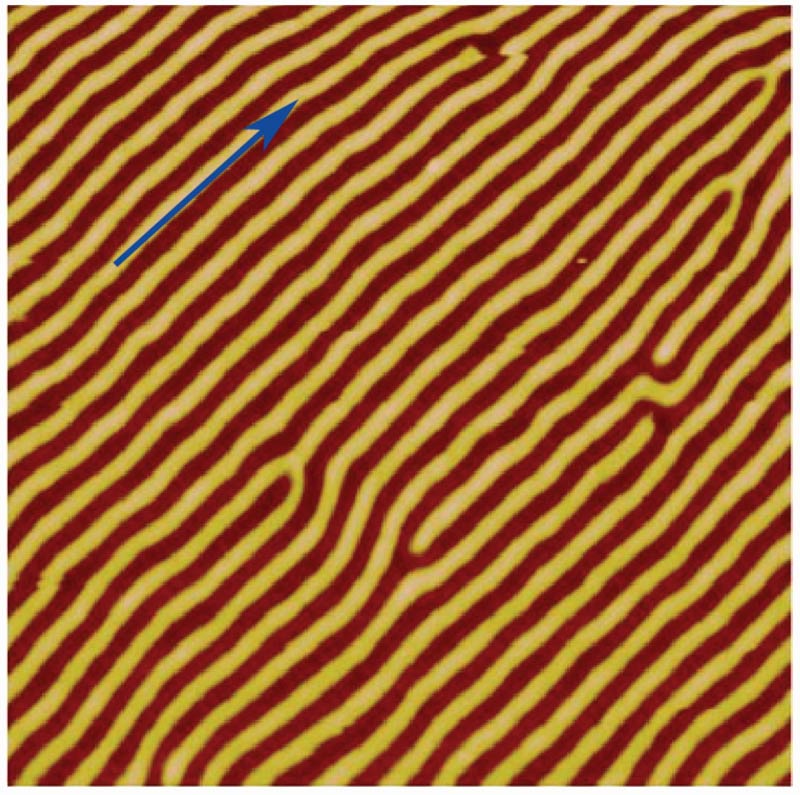Magnet Controls a Superconductor
Magnetic fields can destroy superconductivity–the flow of electric current without resistance–so magnets don’t usually get along very well with superconductors. But in the April Physical Review B, researchers show that by putting a thin magnetic layer on top of a superconducting film and applying a magnetic field, they can tweak the superconductor’s properties in a useful way. Their arrangement makes the superconductor anisotropic, meaning that more current can flow in one direction than in the perpendicular direction. And the specific orientation of these directions is controllable with another field. The technique has potential for superconducting devices.
In most superconductors, a magnetic field that isn’t too strong penetrates the material only through an array of “holes” that allow bundles of field lines to pass through, while the field is blocked elsewhere. The holes are vortices, small loops of electric current that often attach to atomic-scale defects in the structure. A current passing through the superconductor exerts a sideways force on the vortices, and if that force is enough to unpin the vortices and set them moving, energy is dissipated. The dissipation means that moving vortices generate resistance and therefore put an end to the superconductor’s zero-resistance state. The more strongly the vortices are pinned, the greater the current that can pass before resistance appears.
Theorists have suggested that placing a ferromagnetic material on top of a superconductor could enhance vortex pinning. Inside a ferromagnet are regions called domains, each with magnetization–internal magnetic field–lined up in some direction. If an external magnetic field passes through the ferromagnet into the superconductor, vortices prefer to form where the field they contain has the same alignment as a domain in the ferromagnet above. If current pushes a vortex to the edge of such a domain, it should be strongly pinned at the boundary because of repulsion from the adjacent mismatched domain.
Experimenters have found some evidence of this enhanced pinning, but Vitalii Vlasko-Vlasov of Argonne National Laboratory in Illinois and his colleagues sought to exploit the effect in a precise way. They wanted to use the ferromagnet’s domain structure to create a superconductor in which greater current could flow in one direction than in the perpendicular direction. The ability to choose and adjust the preferred direction could make possible new kinds of superconducting sensors and switches, Vlasko-Vlasov says.
The researchers laid a 0.8-micron-thick nickel-iron ferromagnetic layer on top of a 20-micron-thick piece of niobium-selenium superconductor. They then used a standard technique whereby a horizontal magnetic field creates a striped pattern of vertically magnetized domains, with magnetization pointing alternately up and down.
Vlasko-Vlasov and his team then applied a weaker vertical field to create vortices in the superconductor. To image the areas where vortices formed, they capped the structure with a sheet of garnet, a material that changes the polarization of light passing through it when a magnetic field is present. The images showed the vortices moving through the superconductor along the ferromagnetic domain walls. The researchers also found that the maximum current that can be sustained before superconductivity breaks down was about three times higher for currents flowing along the stripes rather than across them. A current always tries to push vortices sideways, but if the current is along the stripes, the vortices become pinned at domain boundaries.
Reapplication of an in-plane magnetic field aligns the striped domains in a chosen direction, Vlasko-Vlasov explains. Eugene Chudnovsky of the City University of New York, one of the theorists who predicted this enhancement of vortex pinning, says that the new work is the first demonstration that the effect can be used “to manipulate the magnitude and anisotropy of the critical current” in a superconductor.
–David Lindley
David Lindley is a freelance science writer in Alexandria, Virginia.





